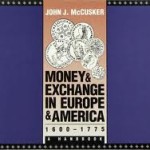Do you need a colonial money exchange rate calculator? Look no further than John J. McCusker's [amazon_link id="0807843679" target="_blank" container="" container_class="" ]Money and Exchange in Europe and America, 1600-1775[/amazon_link]. Yesterday, the Junto invited its readers to submit a list of their favorite books in Early American History for inclusion in their March Madness bracket. Over the next two weeks, the Junto's readers will debate the merits of each book to determine a winner. It promises to be a fun series of historiographical discussions.
Unfortunately, I did not have the chance to nominate my list of books. If I had, I would have nominated John J. McCusker's Money and Exchange in Europe and America. It is one of the most utilitarian books for historians of early America.
 In 397 pages, McCusker furnishes an informative history about the development, usage, and peculiarities of the European and colonial American monies in use between 1600 and 1775 and 65 tables that convey their rates of exchange. From McCusker's tables, scholars can determine the relative buying power of colonists and Europeans. They can also calculate the depreciation and inflation rates for each currency.
In 397 pages, McCusker furnishes an informative history about the development, usage, and peculiarities of the European and colonial American monies in use between 1600 and 1775 and 65 tables that convey their rates of exchange. From McCusker's tables, scholars can determine the relative buying power of colonists and Europeans. They can also calculate the depreciation and inflation rates for each currency.
McCusker readily admits that his study is far from perfect. Many of his tables for the continental colonies contain holes because of an insufficiency of bill rates. However, McCusker goes out of his way to critique his sources and explain why he included or excluded information. For example, McCusker defended his use of merchant manuscripts over prices current to derive his quotations for colonial exchange rates; manuscripts yield actual transactions where prices current offer hypothetical ones (124).
The only outdated part of McCusker's book seems to be its physicality. In our digital age it seems outmoded to use a book to calculate exchange rates, but McCusker's charts are the best method available. Perhaps a digital humanist will engage with these charts and enhance their usability for the twenty-first century.
What Do You Think?
What is your favorite utilitarian history book?
